I think we have reached the end of these color posts, though I suspect you’ll be seeing posts on embroidery for at least another month. The first two colors are still reasonably simple. But on the other two… we have moved from reasonable assumptions, to trickier educated guesses, to just plain hard. I have bought and discarded so much silk trying to figure out those last two dyes. The end result is that the palette is more vibrant than I could have imagined, but also that I doubt myself twice as much.
Color 1 of 4
Of these there is only one that’s easy. So, let’s start there. Cochineal is incredibly light-fast. It has richer cooler colors than madder, which had been the reigning red dye before cochineal came into fashion. I’ve learned from Ercil, my resident dye expert, that cochineal via various mordants and processes can create a stuning range of reds and purples.
It’s made out of a small insect called Dactylopius coccus. They’re most likely to be encounter in modern day Mexico and south America. About 70,000 bugs are required for a lb of raw cochineal and it was being imported from the new world in staggering quantities. In 1587 alone 72 tons of cochineal were shipped from Lima to Spain. Its presence and popularity in Europe was well established by 1620.
I’m going to label cochineal C3 in the diagrams going forward.
(On that note: If this kind of trivia interests you, check out the Secret Lives of Color by Kassia St. Clair.)
Thread color for Cochineal (C3): 3-10 from Suzhou Embroidery Arts & Crafts Shop.
Color 2 of 4
Next up is madder. Madder also has pretty good light fastness all things considered, but not like cochineal. It has warmer undertones and the more it fades, the oranger it looks.
Remember I told you in Part 2 that fustic was pinker than actual pink when faded? Well, we have arrived.
Don’t believe me? Take a look at Catherine Ellis’ blog Natural Dye: Experiments and Results. This particular article, Digging Deeper into a Single Dye – Madder (Rubia cordifolia), is what you’ll want to look at.
Add to that the fact that Tricia Nyugen’s work also confirms the presence of a coral colored pink frequently paired with red and I can be relatively certain in my assumption here.
I’ve labeled madder M2 in the diagrams below.
Thread color for Madder (M2): Dark Begonia Pipers Silks. Please see my disclaimers from Part 1 regarding the quality of Pipers.
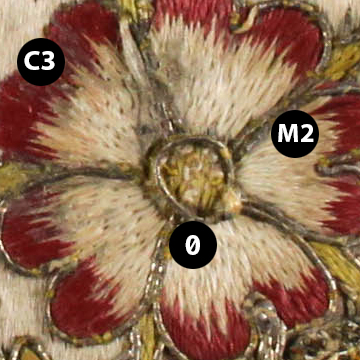
Figure 3
Rose, front cover.
C3 Cochineal ; M2 Madder
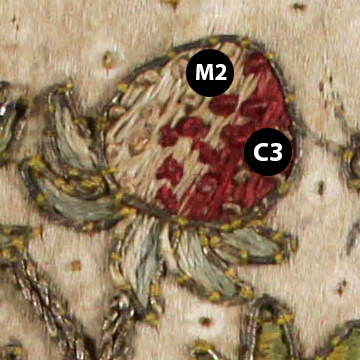
Figure 2
Strawberry, front cover.
C3 Cochineal ; M2 Madder
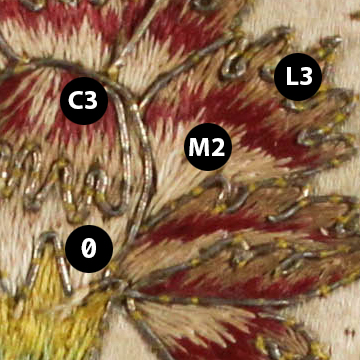
Figure 1
Carnation, back cover.
C3 Cochineal ; M2 Madder ; L3 Logwood
Color 3 of 4
I want to be blunt: I would never have gotten this one without assistance. The wonderful Diane Rudin referred me to Tricia Nyugen’s work, which I ended up using extensively. But she referred me there for this specifically.
Logwood is PURPLE. The kind of purple that people had been craving. Tyrian purple was difficult to make and expensive and there were really no truly good options.
However, logwood dye has terrible fastness and they knew that in period. The Danish book Farvning med planter by Esther Nielsen points out that high quality dyers wouldn’t even allow it in their workshops.
It fades to a warm ruddy kind of purple. And with the wrong mordant (alum) can start practically brown. You can check out some examples of that over at Victory Patterns. Tiina Teaspoon, a fashion lecturer, has also done a number of natural dye experiments including logwood that can be found on her Flikr. (I know: Not as schoolarly as my other resources, but I’m making due with what I have.)
The piece contains multiple shades of logwood dye. I’m going to label them L1 (light), L2 (medium), and L3 (dark).
Thread colors:
- Light logwood (L1): Soie Ovale 3334
- Medium logwood(L2): Soie Ovale 3314
- Dark logwood: I’m using 28-8 from Suzhou Embroidery Arts & Crafts Shop, but you could also use Soie Ovale 3336

Figure 3
Carnation, back cover.
C3 Cochineal ; M2 Madder ; L3 Logwood
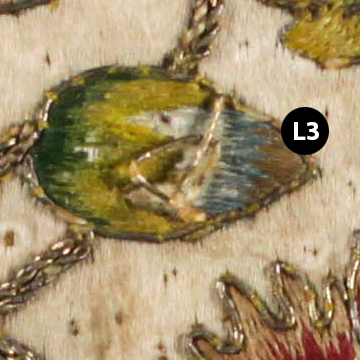
Figure 5
Bud, back cover.
L3 Logwoo
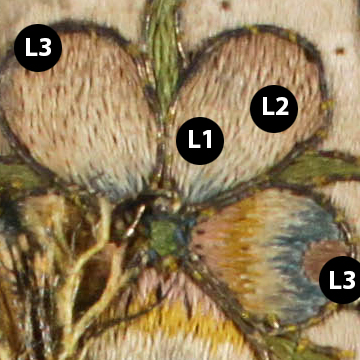
Figure 6
Pansy, back cover.
L1, L2, L3 Logwood
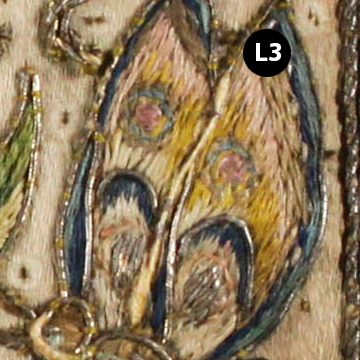
Figure 7
Butterfly, back cover.
L3 Logwood
Color 4 of 4
The last color. But! No. I am not breaking down all the browns.
This color has caused me so much grief. Easily as much as the logwood. Even now, the best I can give you is possibilities. The result is that I am going to label this color P for Purple. Our options narrow down to two choices. It could be:
- Cochineal: As mentioned before, cochineal will actual create a huge range of colors, including ones that veer towards a beautiful pinkish purple. The color is pretty well preserved in my opinion, so it’s in the mix of possibilities.
- Brazilwood: By the mid 1500s there was a thriving market importing Brazilwood from across the Atlantic. The University of Minnesota has a pretty wonderful article, Brazilwood: A Brief History
To make a decision, we’re going to go back to Lightfastness of Natural Dyes by Tim Padfield and Sheila Landi.
Personally, I’m running with the idea that we’re looking at brazilwood not cochineal. Both of them have good staying power, but what’s left has ultimately faded more pink than purple. It’s guesswork without actual chemical testing though. Also, changes to the way the cochineal dying was done could shift the starting point one direction or another and as a result shift the end point.
Here’s the trouble. I don’t really have anything that I consider really truly the right color if it is brazilwood. After buying over 150 spools of embroidery floss: I’m done. I don’t think I’m going to get what I want without dying my own floss and as established in Part 1: I have been forbidden. What I have is pretty close though.
Thread colors from Suzhou Embroidery Arts & Crafts Shop:
- Light Brazilwood (P1): 65-5
- Medium Brazilwood (P2): 65-7
- Dark Brazilwood (P3): 65-9
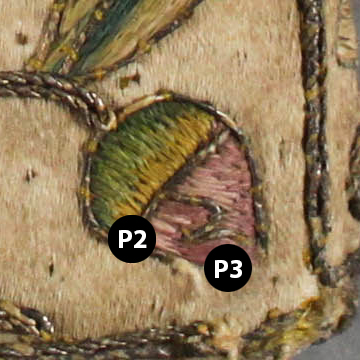
Figure 8
Bud, back cover.
P2 P3 Brazilwood?
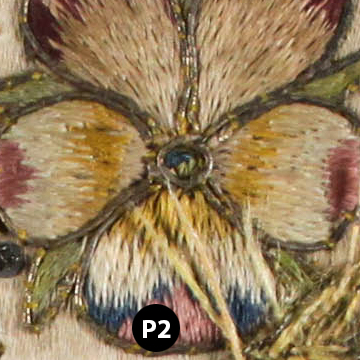
Figure 9
Pansy, front cover.
P2 Brazilwood?
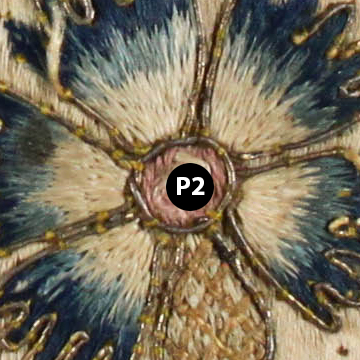
Figure 6
Cornflower, back cover.
P2 Brazilwood?
Deleted:
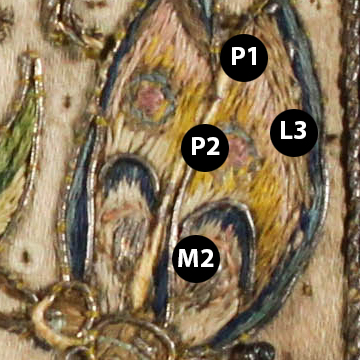
Figure 7
Butterfly, back cover.
P1 P2 Brazilwood?
L3 Logwood ; M2 Madder

Recent Comments